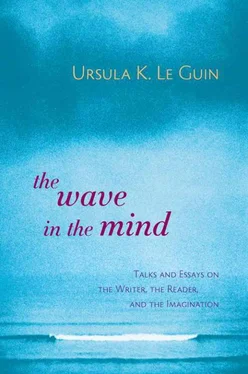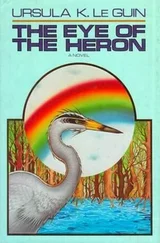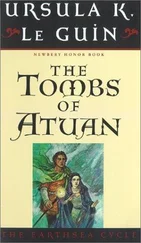I hope you’ll understand that I am not quoting those great words lightly. I do mean it. Knowledge sets us free, art sets us free. A great library is freedom.
So then, after a mad but brief Parisian affair with the Bibliothèque Nationale, I arrived in Portland. Our first years here we had two little babies, and I was at home with them. The great treat for me, the holiday I wanted, the event I looked forward to all week or month, was to get a sitter and come downtown with Charles and go to the Library. At night, of course; no way to do it in the daytime. A couple of hours, till the Library closed at nine. Plunging into the ocean of words, roaming in the broad fields of the mind, climbing the mountains of the imagination. Just like the kid in the Carnegie or the student in Widener, that was my freedom, that was my joy. And it still is.
That joy must not be sold. It must not be “privatised,” made into another privilege for the privileged. A public library is a public trust.
And that freedom must not be compromised. It must be available to all who need it, and that’s everyone, when they need it, and that’s always.
Written for Islands magazine.
Invited to write about a favorite island, at first I couldn’t think of a real one—only the unattained or the imaginary. Islands are by definition separated from the ordinary world, not part of it. Isolate…
So I thought first of the Farallons, those foggy rocks sometimes visible from San Francisco’s Cliff House, dimly seen way out in the grey sea. When I was a child they were my image of the loneliest place, the farthest west you could go. And they have such a beautiful name. Los farallones means cliffs, crags; a lovely word, and in English it gathers echoes—far away and all alone…. But that’s all I know about the Farallons, where I will never go.
So then I thought about islands I’d found in my own mind, the ones I called Earthsea, a whole archipelago occupied by wizards, housewives, dragons, and other fascinating people. I know those islands well; I have written books about them. I gave them fine names, Gont and Roke and Havnor, Selidor and Osskil and The Hands. I never expected to see Earthsea in the real world, but I did, once. I was on a ship that sailed right round the British Isles, up to the Orkneys and the Hebrides, out to Lewis and Harris, to Skye and down the western coast past Scotland and past Wales… and there they were, my islands, scattered before us in a golden sea, fantastic, unearthly, surely full of dragons: the Scillies. Another lovely name. Why are you giggling? Because I saw the Scilly Isles!
But a real island, not a dream or a name or a glimpse?—I couldn’t think of one I could write about. Until I remembered that not all islands are in the sea.
Big oceangoing freighters sail past it every day, sometimes cruise ships, often sailboats, but my island is some eighty miles inland. A faint lift and ebb of the tides is still in the water that flows past it, but it’s not salt water. Sauvie Island lies just downstream from where Portland’s river, the Willamette, enters the immense Columbia.
Sauvie is one of the biggest river islands in the country: fifteen miles long and three or four wide. Along the grey beaches of its outer side runs the broad, powerful current of the Columbia. On the inner side, a slow-flowing slough lets fishermen’s rowboats drift along between the marshes, the clusters of houseboats, the landing stages of old farms. Canals intersect the island, irrigating the farms. Shallow lakes deepen and dry up with the seasons.
In the old days before the dikes were built, before the upriver Columbia was dammed and dammed again, Sauvie Island flooded every year. It was all dairy farms then. The farmers rounded up the cattle when the water rose and drove them onto the few bits of high ground (still called “islands” within the island). There they waited out the flood, some of them mooing and some of them chewing tobacco, I imagine. Then they came back down to the rich, silty pastures. They sent their milk and butter by boat to Portland, just upstream. There was no bridge from the mainland to Sauvie Island until 1950.
There used to be an old man who rowed his boat round the whole island, from farm to farm—every farm had a boat ramp—selling trinkets and buttons and thread and candy: a kind of one-man, two-oared dime store for the islanders. Hearing about those old days, you get the feeling it wasn’t the islanders who wanted the bridge. They were quite content. It was the mainlanders who longed to get across the water. But, racked by the huge trucks we use now, the bridge is threatening to break down, and the farmers of the island are getting a bit desperate, worrying that they won’t be able to get their produce to the Portland markets.
Long before the pioneers, Sauvie was a home and a trading center for the peoples of the river, those marvelous canoe makers for whom the Columbia was not a barrier but a highway. Lewis and Clark called it Wappato Island for the food staple that still grows there, an underwater root with tall lance-shaped leaves. But epidemics brought by early white explorers devastated the Columbia River peoples, and a fur trader wrote of the island people in 1835 that “there is nothing to attest that they ever existed except… their graves.” When the Oregon Trail led homesteaders to the island, they found it desolate. And it still keeps a deep quietness, which sometimes becomes uncanny.
These days, the downstream half of the island is a wildlife preserve—a dreamy silence of marshy woods, huge old oaks, vast flocks of ducks, geese, and trumpeter swans feeding and flying—until hunting season, when it gets noisy for a while. The upstream half is still farmed. I know no place in America that looks so gardened , the way old farmlands in England look; the care and thought with which it’s planted and tended and cherished make it beautiful. But behind the thriving nurseries, berry farms, and pumpkin patches rise the great blue hills above the Columbia, still forested, still half wild. Turn around, and to the northeast see snow-crowned mountains: Hood, Adams, St. Helens looming low since her eruption, and farther north, Rainier. Then all at once, like a mirage, a huge Japanese freighter carrying cars floats quietly by between the pumpkins and the mountains.
Sauvie is only half an hour’s drive from downtown Portland, a city of three-quarters of a million people. The highway to it passes the busy Port of Portland and an industrial district of warehouses, storage tanks, railway sidings, factories; then suddenly there’s a turn to the little two-lane bridge, and you’re deep in the country. Though it is so close, so easy to get to, and so many Portlanders love to go “over to Sauvie’s” to pick strawberries, raspberries, marionberries, blueberries in the summer, buy squash and onions in the autumn, play on the beaches, swim in the river, fish in the slough, hunt or hike the woodland trails, or bird-watch and picnic under the oaks—even so, it remains rural and peaceful, as if it were a piece of the past, timeless between its rivers.
How long can it keep that quietness? So far, it has defended itself against such fatal intrusions as a huge garbage dump and a Japaneseowned golf course for millionaires. So far, no ticky-tacky developments, no McMansions have been allowed on the farmlands or the fish and game preserve. But land-use laws are so easily tossed aside, silence is so easily broken. How long can an island in an ever-deepening sea of humanity remain far away and all alone?
This brief meditation, written in 1996 for the journal Frontiers , where it appeared as “Which Side Am I On, Anyway?” has been rewritten for this book.
Читать дальше



